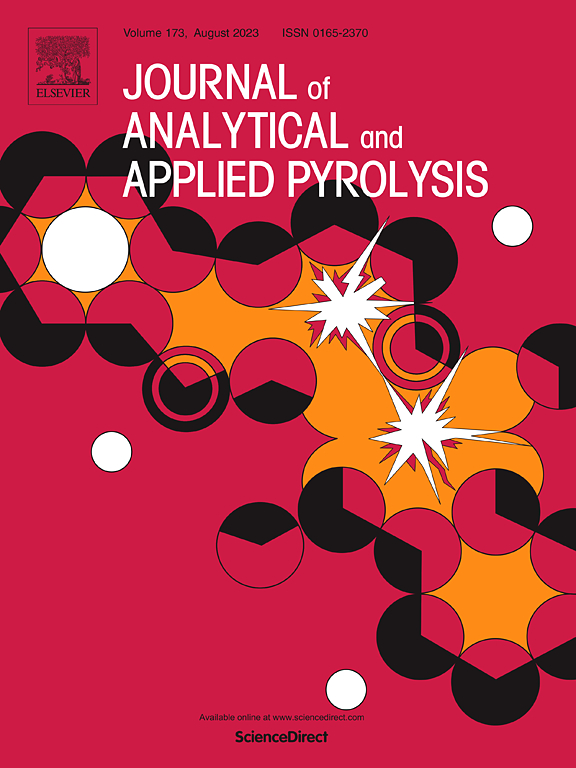红外辐照下纤维素快速热解的高速摄像机观察
IF 5.8
2区 化学
Q1 CHEMISTRY, ANALYTICAL
引用次数: 0
摘要
红外辐照快速热解是一种将纤维素转化为有价值化学品的方法。本文利用高速摄像机研究了红外辐照下纤维素片材(Whatman纤维素)和纤维素粉(Avicel纤维素)在氮气流中的热解行为。在纤维素片材的情况下,热解产物,包括左旋葡聚糖和碳化物质,在反应的初始阶段是局部形成的。随后形成带有薄层热解产物的空穴,并随着空穴的扩大进行热解。对于纤维素粉,在红外照射下,纤维素表面发生热解,热解产物形成液滴。液滴四处移动,收集液体产物,热解产物从液滴中挥发出来。这种热解行为持续到下面未反应的纤维素粉末中,导致所有纤维素在快速热解条件下完全热解。近红外(NIR)光谱分析表明,与未反应的纤维素相比,热解产物、液态产物和炭化产物更有效地吸收了红外辐射。固体炭化产物的加入有效地促进了快速热解反应。这些发现对纤维素在红外辐照下的快速热解具有重要意义。本文章由计算机程序翻译,如有差异,请以英文原文为准。
High-speed camera observation of cellulose fast pyrolysis under infrared irradiation
Fast pyrolysis using infrared irradiation is a method for converting cellulose into valuable chemicals. In the present study, the pyrolysis behavior of cellulose sheets (Whatman cellulose) and cellulose powder (Avicel cellulose) under infrared irradiation in a nitrogen flow was investigated using a high-speed camera. In the case of cellulose sheet, pyrolysis products, including levoglucosan and carbonized materials, were locally formed in the initial stage of the reaction. Subsequently, holes with a thin layer of pyrolysis products were formed, and pyrolysis proceeded as the hole expanded. For cellulose powder, pyrolysis occurred on the surface of the cellulose exposed to infrared irradiation, and droplets of pyrolysis products were formed. The droplets moved around, collecting the liquid products, and pyrolysis products volatilized from the droplets. This pyrolysis behavior continued into the unreacted cellulose powder below, resulting in the complete pyrolysis of all of the cellulose under fast pyrolysis conditions. Near-infrared (NIR) spectroscopy revealed that this characteristic pyrolysis behavior was due to the more efficient absorption of infrared radiation by the pyrolysis products, liquid and carbonized products, compared to the unreacted cellulose. It was also found that the addition of solid carbonized products efficiently promoted the fast pyrolysis reactions. These findings have important implications for the fast pyrolysis of cellulose under infrared irradiation.
求助全文
通过发布文献求助,成功后即可免费获取论文全文。
去求助
来源期刊
CiteScore
9.10
自引率
11.70%
发文量
340
审稿时长
44 days
期刊介绍:
The Journal of Analytical and Applied Pyrolysis (JAAP) is devoted to the publication of papers dealing with innovative applications of pyrolysis processes, the characterization of products related to pyrolysis reactions, and investigations of reaction mechanism. To be considered by JAAP, a manuscript should present significant progress in these topics. The novelty must be satisfactorily argued in the cover letter. A manuscript with a cover letter to the editor not addressing the novelty is likely to be rejected without review.

 求助内容:
求助内容: 应助结果提醒方式:
应助结果提醒方式:


